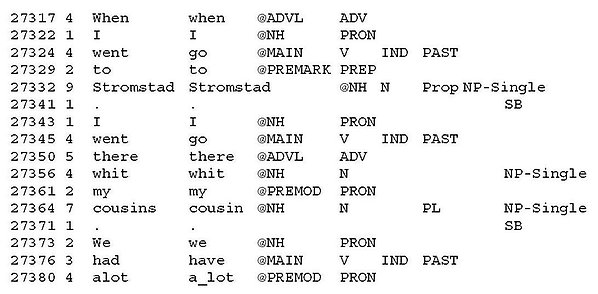Syntactic Aspects of the Writing of Swedish L2 Learners of English
This project focuses on measuring syntactic development in the writing of Swedish high school students. The writing process is an important component of the teaching of English in Swedish schools. Instead of measuring the quality of students’ written production such as the proportion of grammatical errors, the current project intends to provide new, alternative methods for measuring syntactic development.
The data is drawn from the Uppsala Learner English Corpus (ULEC), consisting of essays written by Swedish junior and senior high school students. The students write their essays in a web window, and the finished essay is saved on a server. The essay task is set by trainees in the teacher training programme at the Department of English as part of their degree projects. These trainee teachers also enter information about school level, high school program, and categorize the essay as ‘argumentative’, ‘descriptive’ or ‘narrative’. Currently, ULEC contains approximately 170,000 words (19,000 words from junior high school and 151,000 words from senior high school. A short text sample is given in (1).
(1) <D 20081104><G ARG><Y 3><K C><P S><S M><A 18>
I think that people is fascinated by the unknown because they are scared of it. Like sharks or crocs, you can’t see them, that’s what scaring about them, but you are also fascinated by them. For example, who doesn’t like the Jaws movies? (male student, aged 18, senior high, year 3, English C, academic program)
In measuring syntactic development in the students’ writing, we make use of various indices, including number of T-units, proportion of syntactically error-free T-units, and the subordinate clause index. In the statistical analysis of the data, syntactic development is analyzed across age, school level, and gender. Senior high school students write longer and more complex T-units, in that they have a more frequent and varied use of subordinate clauses (see Figure 1). Contrary to previous research on gender differences in second language acquisition, results show that, controlling for age and school level, there are no statistically significant differences between boys and girls when they write essays in English.
In a future project, we will use a POS-tagged version of ULEC to investigate the degree of premodification in student writing as an additional indicator of syntactic development, as in (2) and (3).
(2) Untagged sample from a male student, aged 13, in grade 7, junior high school:
<D 20080530><G DESC><Y 7><K A><P S><S M><A 13>
When I went to Stromstad. I went there whit my cousins. We had alot of fun! I and my brother fished and catched crabs, that was really fun. Me and my youngest cousin played in the sand, we build sandcastles nearly every day, he had alot of fun whit me and I whit him. I was there in two weeks. I did bath every day but one.
(3) Tagged extract from the ULEC corpus:

Figure 1. Indicators of syntactic development across Level (Junior high school and senior high school).
Publications:
Johansson, Christine. 2006. “Supplemental instruction och lärarstudenters intresse för grammatik i språkundervisningen och i examensarbeten”. In Approaches to Teaching and Learning in Linguistic Research: Papers from the ASLA Symposium in Växjö, 10–11 November, 2005, eds. Jan Einarsson, Eva Larsson Ringqvist and Maria Lindgren. Uppsala: Svenska föreningen för tillämpad språkvetenskap, 101–111.
Johansson, Christine and Christer Geisler. 2009. “The Uppsala Learner English Corpus: A New Corpus of Swedish High School Students’ Writing”. In Multilingualism: Proceedings of the 23rd Scandinavian conference of linguistics, eds. Anju Saxena and Åke Viberg. Uppsala: Acta Universitatis Upsaliensis, 181–190.
Johansson, Christine and Christer Geisler. Forthcoming. “Syntactic Aspects in the Writing of Swedish L2 Learners of English”. To appear in Corpus-based Studies in Language Documentation, Use, and Learning, eds. John Newman, Sally Rice and Harald Baayen. Amsterdam: Rodopi.
